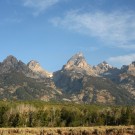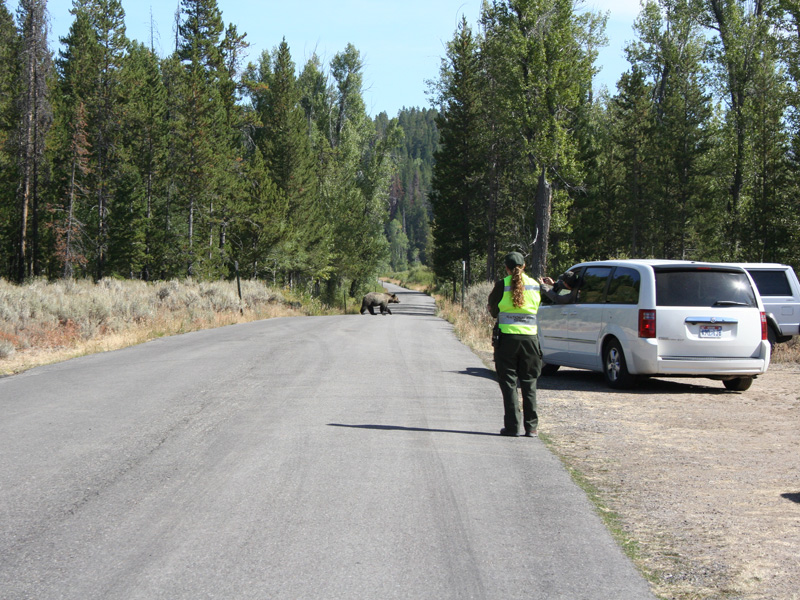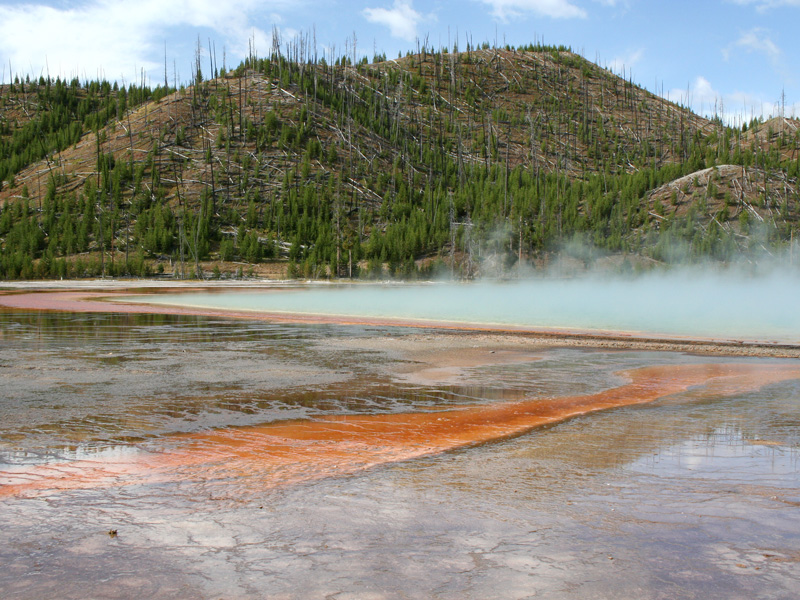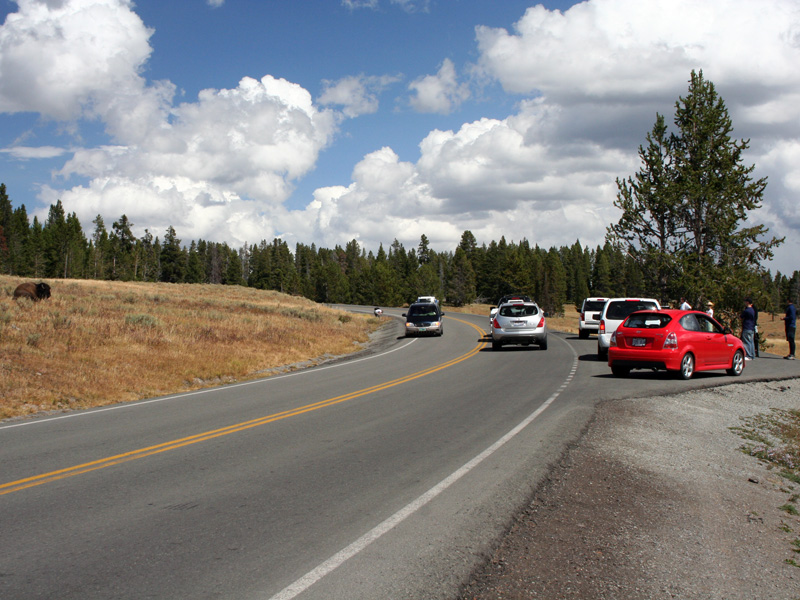Bears… Oh My!

On Friday they arrived at their hotel in Jackson Hole (Teton Village) late evening after a long but beautiful drive through the Wyoming landscape. Although it is difficult to imagine a landscape more beautiful and serene then the Colorado landscape dotted with red rock canyons, rolling hills and rock formations that rival Rodin’s exquisite sculptures, Eastern and Central Wyoming offers vast expanses of plains and grasslands farther than the eye can see. During the drive, it was hard not to be truly awestruck by the vivid colors of the sky as the sun sets over the Rockies which spill over into Wyoming from Colorado! At this point, it’s easy to imagine why Kathleen Bates penned the words to the song, “America the Beautiful.” Although her inspiration for the song was the Pike’s Peak mountain range in Colorado, this beautiful Wyoming view would certainly fit as well!

The Teton Mountains
After checking into the hotel there was very little time to do anything but settle in for a very early wake up the next morning. However, Rita noticed a local magazine in their room with some bears on the cover and a headline titled, “The Saga of #399.” Although she read the article with great interest just before retiring, little did she know there would be a very personal connection forthcoming!
Knowing full well that it would be extremely difficult to see all that the Tetons and Yellowstone has to offer in just two days…..Art sought help to make the most of their day in the Tetons. They hired and met Brad Cole, their guide, at 6AM on Saturday. Brad is a wildlife biologist and an employee of the Teton Science School which is a non-profit organization dedicated to the education and scientific advancement of the Grand Teton National Forest. Brad arrived in an SUV and promptly made them fill out the typical “this activity can be dangerous and life-threatening and I take full responsibility for whatever happens” forms before heading out. He then handed them each a pair of binoculars and gave a little background about himself and the school. They got to know each other, then set out to learn and explore. The temperature was in the low 30’s and the chill in the air made their anticipation even more exhilarating!
Brad’s knowledge of local wildlife and all things natural is very impressive. This was first evidenced by his uncanny ability to spot even the slightest movement in almost total darkness. As they rounded a corner on an unpaved road he slowed the SUV and pointed to a field and said, “Look out there….a herd of Elk are grazing.” He stopped the vehicle so they could focus their binos toward where he was pointing. All the while Rita was thinking, “you’ve got to be kidding….how on Earth can you see anything?!” But once the focus was made and the eyes adjusted to the darkness they could make out the silhouettes of the magnificent creatures. There were about 8-10 ungulates (new word Art and Rita learned, meaning “hoofed animals” including Elk) consisting of females and their young and several of them looked toward the SUV seeming a little skittish about being watched. Brad explained that even low light can seem very bright to these animals due to their heightened sense of sight. Camera flashes can seem like a super-nova to them and can be quite bothersome, so no pictures were taken to ensure minimal disturbance to them.
As they left the Elk herd foraging for their morning meal, daylight started to break and they continued down the road heading toward the Park entrance. As they slowly made their way Brad pointed out bear “scat” (poop) on the road and stopped to look at it. He indicated that the scat was fairly fresh which meant bears were certainly in the area. They were no doubt feeding on the Serviceberry bushes which were growing alongside the road. Art and Brad seemed to be fascinated by the scat….Rita….not so much! Brad said that bears spend most of their day either searching for food or consuming food in order to bulk up in weight before winter hibernation which usually begins in early October. Serviceberry’s offer added nutrition to the bear diet.
They continued on and came upon another herd of Elk on the hillside to their left. This herd was a little different in that there were many more of them (possibly 30-40) and there was a dominant bull male and a younger satellite male in the group. Brad informed that most male Elk will hang out in “bachelor” groups until mating season at which time they will break away to find females with which to mate. He said mating season for the Elk is soon but not quite yet so found this to be quite peculiar. Brad then said the male was going to “bugle” (or call) and sure enough…he did! This was the bull Elk’s way of trying to attract females of the group as mates. The call lent an otherworldly sound to the autumn air! How he knew the elk was getting ready to bugle was certainly uncanny.
They moved on and within what seemed like just minutes found themselves in a large grassy field. Brad stopped the SUV and pointed out toward the horizon. They all got out of the vehicle and Brad set up the spotting scope so Art and Rita could look into it. They saw a beautiful herd of American Pronghorn way out in the distance. They were hard to spot with the naked eye but were easily visible with the scope or the binos as they truly blended into the grasses they were feeding on. They were about 1,000 yards away. Incredibly, they were looking toward the vehicle. Rita asked about them and Brad informed that they have acute visibility and can outrun a Cheetah! They can reach speeds of up to 60 mph and can make leaps over 25 feet. They look like a cross between a mule deer and an antelope but are neither. They are the only horned animals that shed their horns which makes them a unique family. Prior to 1862 it is estimated that there were between 50-100 million Pronghorn roaming the great Western plains. Unfortunately, in 1862 the US Govt passed the Homestead Act of 1862 allowing settlers to buy land cheaply (some as little as $.10 per acre.) As the settlers moved in they hunted the Pronghorn and other plains animals for food and interrupted their roaming ranges by putting up fences. Within 100 years only 750,000 Pronghorn remained! Fortunately they are protected under the Endangered Species Act so their numbers continue to climb.
After a few more stops and discussions it was time to grab a bite to eat at a local place called Trapper Grill at Signal Mountain Lodge. The lodge is situated on the edge of a large lake called Jackson Lake. The food was great and the view was spectacular! The lunch discussion centered on some of the projects the School supports and the role of the staff and students. It was amazing to learn that the school is completely self supported and does not rely on tax dollars for its existence. Art, Brad and Rita discussed other topics such as land management, Wyoming land and mineral rights, the economy, raising children and a host of other varied topics. After lunch they all headed out in search of other interesting sites.
They drove around the valley for about ½ hour when they came upon a small contingent of cars on the side of the road. They were all looking in the same direction, across a small grassy area (roughly 300 yards) and onto a small hillside. The hillside was covered with Serviceberry bushes and in the middle of those was….you guessed it….a grizzly bear! However, this was no ordinary grizzly. This was one of three 2-year old bear cubs of Grizzly #399. The same #399 in the article that Rita read about just the night before! Why the article? Grizzly #399 (donned that number by the US park rangers who track these animals for research purposes) has uniquely chosen to raise her cubs on the fringes of the parks borders in order to avoid predation from larger male grizzlies who prefer roaming areas less inhabited by humans. By doing so, this has put her and her cubs in the frequent path of park visitors and hunters…yes, hunters! The Teton National Forest allows hunting of moose and elk. Unfortunately this can mean tragic encounters for both bear and humans. Hunters will often track and down an animal (typically Elk or Moose.) They will quickly “dress” the animal, leave the remains (known as a gut pile) and carry out the meat for consumption later. Bear have acute senses of smell and can smell these gut piles from miles away. They have come to rely on these as a food source since the olmentum (a part of the gut) of the animals have high fat content which helps the bear put on weight for their long winter hibernation. Fortunately, #399 successfully (although not without incident) raised her cubs and just last April separated from them to mate and produce more offspring. While this family of grizzlies has been able to survive in the park, their future is very uncertain as they live perilously close to humans. This particular cub was one of two females #399 produced of the litter of three.

Grizzly crosses the road.
The female cub was roaming along the hillside feasting on the Serviceberries. Art, Rita and Brad were watching the bear but were equally as interested in watching the roadside spectacle that was taking place. More and more cars began to arrive and more and more people congregated to watch the bear. Fortunately, park rangers are very in tune with the whereabouts of the less than 60 bear that roam the 4.4 million acres of the National Forest. There was a young female park ranger (who lives just outside Denver and works in the park during the summer months) in the midst that was there to ensure safe viewing of the bear. The bear began to make her way down the hillside and toward the road where the crowd was congregating. She was obviously intending to cross the road into the thick forest on the other side. The park ranger began to push the crowd back to allow ample space for the bear to cross. Just at that time a large SUV full of tourists drove up and stopped in the middle of the road, directly in the path of the bear. The park ranger yelled for the vehicle to continue moving. It did not. She yelled louder. It did not move. By this time, the bear was about 100 yards from the road – still moving on her path. The park ranger was forced to walk up to the vehicle to get them to move out of the way….clearly placing herself within a dangerously close range of the bear. She did this to protect the bear and the other onlookers. Fortunately the vehicle moved and the bear was able to make her way across the road. As she did, the roadside onlookers began to run toward the bear as it crossed the road into the forest, in hopes of catching that perfect snapshot. Art, Rita and Brad were back in the distance trying not to be part of the spectacle. The bear sensed the rush and picked up her pace into the forest to avoid the “bear paparazzi” as Brad called it! It was a very sad sight to watch. The bear was terrified and the onlookers frenzied.
When wild animals feel threatened and try to defend themselves it can often times lead to their own destruction as park rangers are often forced to put down an animal that has been known to attack a human. Bear #399 has escaped a close call with just this fate. (See the attached article for the #399 story.) The female park ranger had said that so far this year 4 bears were put down and as many as 17 were destroyed in prior years. Although there are 4.4 million acres in the local national forests, the terrain ranges from high mountain alpine glaciers to low valley marshland. The areas conducive to supporting bears are usually the same areas that attract humans (lake areas, hillsides, forested areas, etc.) It will be truly miraculous if #399 and her three cubs can avoid problems with humans. So it was with very mixed emotions that Art and Rita were able to view an amazingly magnificent creature as this grizzly in the wild. They were very quiet as they got back into the vehicle and left the “bear jam” on the road. Then, within 10 minutes they passed another “bear jam.” As they drove by, they saw the other female cub of #399 in a marsh area off the side of the road trying to cool off. They decided not to stop this time….they just kept on driving. What will be the fate of this family of bears?
After a few more hours of driving with Brad through the Teton valley learning about the geological range formations, local flora and other interesting facts about the area he brought them back to their hotel. It was hard to believe that 9 hours had flown by! They thanked Brad for a truly enlightening day and he disappeared as quickly as he arrived. The work he and the other school staff do is clearly important to the park and the wildlife the park supports.
Art and Rita then checked out of their hotel and proceeded to drive to their next destination, Jackson Lake Lodge which is situated on the edge of Jackson Lake just inside the Teton National Forest. When they arrived they settled in to their “cottage” which had no TV, no radio and no internet. All of these modern “comforts” could be found in the main lodge but not in the rooms. Art was a little bummed out so Rita found a small pizza place they could go for dinner….knowing the best way to cheer Art is always with pizza! After dinner they decided to purchase a DVD at the lodge store about the area and watch that on Art’s laptop. They made it halfway through before falling asleep totally exhausted from the activities of the day!
On Sunday the plan was to explore Yellowstone National Park, America’s first national park. Unfortunately it appeared that Mother Nature was not going to cooperate as Art and Rita awoke to rain and gray skies (first in the area in months…of course!) However, this did not stop their adventure. They had breakfast at the lodge and quickly headed out toward Yellowstone. They made their way to the entrance within about an hour and the rain had subsided to a light drizzle. They drove another hour or so before reaching “Old Faithful.” By this time, the rain subsided and the sun was starting to appear through the clouds….luck was on their side once again.
Yellowstone is truly a magical place. It is a wonderland of geysers (more than 300 of them), brilliantly colored hot springs, bubbling mud pots and steaming fumaroles. The park has half of the Earth’s geothermal features and is situated on a great caldera that reminds us of the Earth’s great volcanic past. Having only a few hours to spend in the park, Art and Rita decided to tour the southern loop of the park and leave the rest for another visit. The day was spent viewing spectacular colorful and vivid springs and geysers! The beauty of this place is truly something that should be seen by all. The aqua and blue iridescence of the waters of the hot springs were mesmerizing. And knowing that the water is over 190 degrees makes one feel a little unnerved walking along the boardwalks with no railings! Signs along the pathways indicate past visitors have indeed had some issues with this.

Yellowstone
Watching the geysers was great fun! Even more fun was watching the onlookers as the geysers rushed forth….like being at a fireworks show hearing all of the “oohs” and “aahs!” The smell was very unique. Not quite sulfurous but definitely a hint of ash, earth and vapors all mixing to create a pungent yet not too offensive odor. (Art might not agree with this though.) It was difficult to keep one’s mind off of the fact that you were standing within a very active geothermal area that could erupt anywhere, anytime.
The drive along the southern loop was beautiful. Wildlife is abundant in Yellowstone. It is home to Elk, Moose, Buffalo, Wolves, Birds, etc. Art and Rita rounded a corner on the road and came upon another situation like the “bear jam” the day before. Only this time the attraction was a sole Buffalo lying on a small hillside just off the side of the road. People were again trying to position for the best view or picture spot. Art and Rita parked hundreds of yards away, out of the site of the animal to watch the spectacle. Some of the people were less than 50 yards from the animal – which, by the way, has the ability to run quickly and has large horns! They were nuts – what were they thinking!? As other cars rounded the corner they would slow and create traffic issues….no park ranger around this time. Art and Rita felt that sickening feeling again for the poor beautiful animal that was being mongered by the crowd of people. Again, they drove away in silence.

Buffalo Jam
The day drew to a close and they traveled back to Denver the following day with so many unexpected experiences and new observations.
With mixed emotions, it is hard to appreciate the beauty of nature without being a participant of it. It is clear from just these few humble observations that we all have to be good stewards of nature rather than “users” of it. Our native ancestors were so well aware of this fact. They left very soft footprints that are barely visible today. Unfortunately, that cannot be said of us today. Our footprints are not so soft and definitely not barely visible! It is incumbent upon each of us to act in ways that are protective of our natural resources when possible.
Theodore Roosevelt was certainly a true visionary when he enacted legislation to create the very first national park of Yellowstone. This lead to an entire system of national parks within the US and it lead the way for other countries to create protected natural resources and lands as well. Our national parks are certainly a treasure….millions and millions of visitors roam them every year, many of them not from within our borders. The ability to get this close to nature is a privilege indeed and one not to be taken lightly or for granted.

